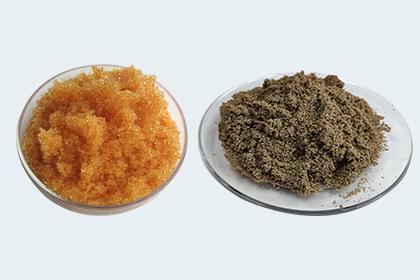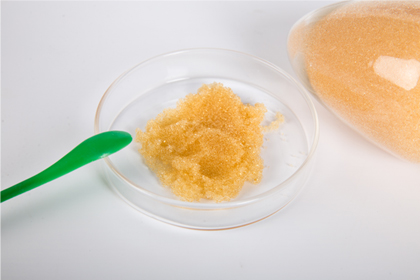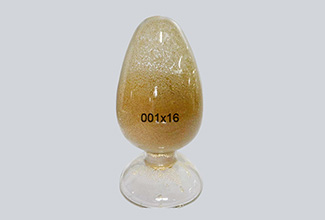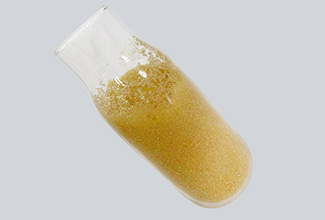Why do we choose macroporous cation exchange resins?
Macroporous cation exchange resins have demonstrated significant advantages in a number of fields, especially in fatty acid production and enzyme-catalyzed reactions.
Highly efficient hydrolysis: In fatty acid production, macroporous cation exchange resins can effectively promote hydrolysis reactions, especially under high temperature and high pressure conditions, such as continuous high-pressure fat hydrolysis using superheated steam, and can achieve hydrolysis rates as high as 96-98% in a short period of time (e.g., within 2 hours), which significantly improves production efficiency.


Environmentally friendly: Compared to traditional high temperature and high pressure hydrolysis, the enzyme-catalyzed reaction using macroporous cation exchange resins usually takes place at ambient temperature, reducing energy consumption and carbon emissions, and avoiding the production of corrosive acids under high temperature and high pressure, which is good for the environment.
Suitable for heat-sensitive fats and oils: The enzyme-catalyzed process is gentle and particularly suitable for treating heat-sensitive fats and oils, such as certain vegetable oils that are prone to deterioration at high temperatures, thus expanding the range of raw material choices.
Improvement of reaction rate: By optimizing the structure and properties of the resin, the enzyme loading and catalytic activity on the resin can be enhanced, thus accelerating the reaction rate and shortening the production cycle.
Easy recovery of catalyst: The enzyme can be effectively immobilized by the macroporous cation exchange resin, which not only improves the stability and reusability of the catalyst, but also simplifies the recovery process of the catalyst and reduces the production cost.
Controllable reaction conditions: By adjusting the pore size, exchange capacity and other parameters of the resin, the reaction conditions, such as substrate concentration and pH, can be precisely controlled, thus optimizing the reaction process and improving product quality and yield.
Promote industrial application: Although the enzyme-catalyzed process has advantages in small-scale production, the application of macroporous cation exchange resins provides a new pathway for the immobilization of enzyme catalysts. By optimizing the process conditions and reactor design, it is expected to realize the industrial production of enzyme-catalyzed reactions, and to promote the greening and high efficiency of the production of fatty acids and other chemicals.
Highly efficient hydrolysis: In fatty acid production, macroporous cation exchange resins can effectively promote hydrolysis reactions, especially under high temperature and high pressure conditions, such as continuous high-pressure fat hydrolysis using superheated steam, and can achieve hydrolysis rates as high as 96-98% in a short period of time (e.g., within 2 hours), which significantly improves production efficiency.


Environmentally friendly: Compared to traditional high temperature and high pressure hydrolysis, the enzyme-catalyzed reaction using macroporous cation exchange resins usually takes place at ambient temperature, reducing energy consumption and carbon emissions, and avoiding the production of corrosive acids under high temperature and high pressure, which is good for the environment.
Suitable for heat-sensitive fats and oils: The enzyme-catalyzed process is gentle and particularly suitable for treating heat-sensitive fats and oils, such as certain vegetable oils that are prone to deterioration at high temperatures, thus expanding the range of raw material choices.
Improvement of reaction rate: By optimizing the structure and properties of the resin, the enzyme loading and catalytic activity on the resin can be enhanced, thus accelerating the reaction rate and shortening the production cycle.
Easy recovery of catalyst: The enzyme can be effectively immobilized by the macroporous cation exchange resin, which not only improves the stability and reusability of the catalyst, but also simplifies the recovery process of the catalyst and reduces the production cost.
Controllable reaction conditions: By adjusting the pore size, exchange capacity and other parameters of the resin, the reaction conditions, such as substrate concentration and pH, can be precisely controlled, thus optimizing the reaction process and improving product quality and yield.
Promote industrial application: Although the enzyme-catalyzed process has advantages in small-scale production, the application of macroporous cation exchange resins provides a new pathway for the immobilization of enzyme catalysts. By optimizing the process conditions and reactor design, it is expected to realize the industrial production of enzyme-catalyzed reactions, and to promote the greening and high efficiency of the production of fatty acids and other chemicals.
Next Article :
Related Products
-
 D001macroporous cation ion exchange resinAppearance: Light brown opaque spherical particles.Ionic form:Na+Volume complete exchange capacity(mmol/ml): ≥1.80
D001macroporous cation ion exchange resinAppearance: Light brown opaque spherical particles.Ionic form:Na+Volume complete exchange capacity(mmol/ml): ≥1.80 -
 001x16 Strong Acid Cation Exchange ResinAppearance: Claybank to tan transparent spherical particle.The degree of crosslinking : 16%.Ionic form:Na+
001x16 Strong Acid Cation Exchange ResinAppearance: Claybank to tan transparent spherical particle.The degree of crosslinking : 16%.Ionic form:Na+ -
 Strong Acid Cation Exchange Resin for water treatmentAppearance: Claybank to tan transparent spherical particle.The degree of crosslinking : 10%.Ionic form:Na+
Strong Acid Cation Exchange Resin for water treatmentAppearance: Claybank to tan transparent spherical particle.The degree of crosslinking : 10%.Ionic form:Na+
Message

